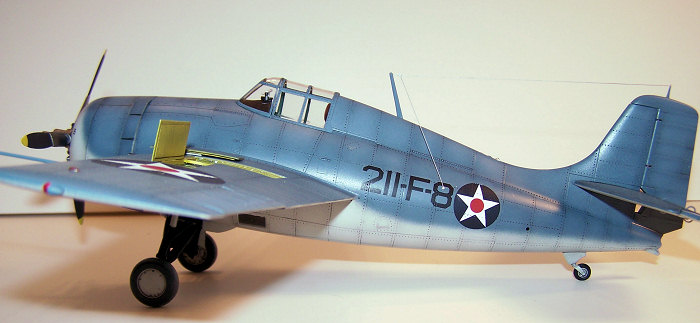
Trumpeter 1/32 F4F-3 Wildcat
| KIT #: | 02225 |
| PRICE: | $54.95 MSRP? |
| DECALS: | Two options |
| REVIEWER: | Bill Koppos |
| NOTES: | Eduard photo etch and Yellow Wings decals used. |

| HISTORY |
The overall history of Grumman's feisty F4F has been covered in many
places, including Tom Cleaver's recent and excellent review on this site. Here,
I will concentrate on the unreal accomplishments of the Wildcat in the hands of
Marine Fighting Squadron VMF 211 during the famous siege of Wake Island,
December 8th to 23rd, 1941.
The story of this siege and the Islands tiny Air Force has always fascinated me, along with similar stories such as the Malta Gladiators and the Bataan P40's. Finally I was able to do a proper F4f-3 Wildcat representing VMF211, thanks to Trumpeters release of a nice kit of this bird. Also fueling the fire was a book by Gen. John F. Kinney, "Wake Island Pilot", which gave me some information I never had before. Kinney was not only a pilot with VMF211, but it's engineering officer, responsible for keeping the battered cats in the air. Specific details and the few available photos set me in motion.
VMF211 received the F4F-3 in October of 1941, having little time to familiarize themselves with their new fighters before 12 planes and pilots were assigned to a "practice mission" on board the carrier Enterprise on November 27th. Once on board, it was revealed to the squadron that they were headed for Wake Island, to provide air defense for the 1st Marine Defense battalion based there. All they had with them were overnight bags, and the clothes on their backs. Kinney describes the condition of the Wildcats at the time- no armor plate or self sealing tanks, no homing devices of any kind, not even any kind of gun sights. The commander of 211, Paul Putnam, knew they were in trouble when the Navy stripped the Wildcats aboard of their gun sights and installed them in the Marine F4Fs, as the Navy never gave up anything easily to the Marines! He felt, he said, as if he were a "fatted calf". Also, the Navy replaced a Wildcat that would not start during loading with one from their stock. Of interest to me was Kinney's description of how this airplane was repainted by a Navy paint crew to "match" the Marine's aircraft, this being light grey underneath and Blue on top. Were the Navy planes still in overall light grey? In any case, on December 4th, the 12 planes were launched for Wake.
More surprises awaited on the Island. The coral runway was not yet finished, nor the protective revetments for the fighters. A maintenance/ground unit had been sent ahead by ship, but there were few trained mechanics and NO Wildcat shop manuals. As Wake was bereft of radar also, patrols were immediately instituted. 4 planes were always aloft, as full war warnings were in effect. John Kinney was one of the pilots on duty on the fateful morning of December 8th, 1941, December 7th in Hawaii.
One of the features of Wake atoll is the loud
surf, which along with thick cloud cover allowed 34 twin ruddered Japanese
G3M bombers to burst over the atoll with complete surprise. Destruction was
enormous, the worst disaster being at the airfield, where 7 Wildcats were
wrecked and the other damaged. Loss of life was bad, including several pilots
and mechanics. The planes on patrol missed the bombers completely, returning to
the scene of devastation with shock. There was nothing to do but pick up the
pieces and fight. Kinney was now
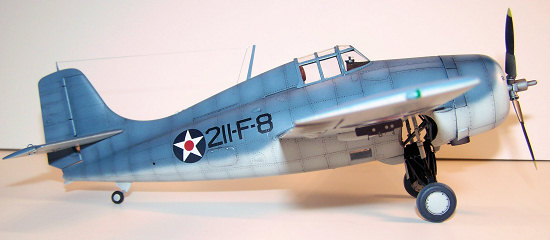 given the task of keeping the
remaining planes airworthy, and getting the damaged Wildcat back in the air.
According to his book, this was F4F number 8. Quick figuring showed the Japanese
could only have come from the Marshall Islands, and would be attacking around
the same time during the day. Four Wildcats, therefore were duly aloft and ready
when the Mitsubishis arrived the next day, Number 8 among them. These F4Fs made
the first of countless Wildcat kills of the Pacific war by downing two of the
raiders. Wake's Air Force had drawn first blood. December 10 bought another
raid, and two more downed bombers. But the bombings were not stopped, and damage
was mounting. The next day would bring a supreme test to Wake's defenders.
given the task of keeping the
remaining planes airworthy, and getting the damaged Wildcat back in the air.
According to his book, this was F4F number 8. Quick figuring showed the Japanese
could only have come from the Marshall Islands, and would be attacking around
the same time during the day. Four Wildcats, therefore were duly aloft and ready
when the Mitsubishis arrived the next day, Number 8 among them. These F4Fs made
the first of countless Wildcat kills of the Pacific war by downing two of the
raiders. Wake's Air Force had drawn first blood. December 10 bought another
raid, and two more downed bombers. But the bombings were not stopped, and damage
was mounting. The next day would bring a supreme test to Wake's defenders.
Pre- dawn of December 11th bought electrifying news- a Japanese invasion force was offshore. Having only 5 inch guns to fight with, the Commanders of the defense battalion knew their only chance was to draw the enemy to very close range. Orders were issued to hold fire, and the planes were kept grounded so as not to "Give the show away". At about 5 A.M. shells began raining down on Wake Atoll. Receiving no return fire, the bombarding ships came in closer-closer-when suddenly 5 inch projectiles began slamming into cruiser "Yubari", the flotilla leader. Other ships started taking numerous hits, and the bombardment force made smoke, turned and ran. Destroyer "Hayate" split in two and sank, the first major ship loss of the war for the Japanese.The eager Marine flyers were finally allowed to take off, loaded with 100 pound bombs on modified racks. Four Wildcats barreled into the Japanese fleet, strafing and bombing in relays. John Kinney was diving for an attack when Destroyer "Kisaragi" blew up under him, apparently a victim of her own depth charges. The Wildcats clawed at the remaining ships until they finally steamed out of range. But the victory had been costly to Wake's small Air Force. No. 11, shot up, crash landed and was written off. No. 8 had 2 engine cylinders shot out, the others damaged in varying degrees. There was no sleep for Kinney and company this night. By any standards it had been a terrific victory, the only time during the war an invasion attempt was beaten off by shore guns (and a few good flyers).
The next ten days melted into an exhausting
blur of daily air raids and constant repair jobs in an attempt to keep Wake's
Wildcat's flying. 2 cylinders were robbed from wrecked no. 5 to keep no.8
going, but every day it became harder to coax into action. Several bombers
fell, but gun malfunctions became frequent. When no. 10's tail section was
crunched in a raid, the engine was stolen from the wreck and used to replace the
balky one in no. 9. So it went, until the morning of Dec. 22nd. No Grummans were
aloft that morning when Japanese carrier aircraft swept in. The surviving
Grummans were safely hidden this day, but the
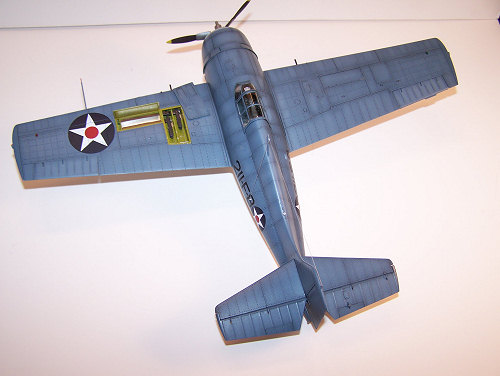 outlook for the future was grim.
What could have been going through the minds of the men of VMF211 this evening?
There was nothing left to do but their duty. Accidents and damage had reduced
the Air Force to 2 machines- chances seem to be these were no.'s 9 and 8.
outlook for the future was grim.
What could have been going through the minds of the men of VMF211 this evening?
There was nothing left to do but their duty. Accidents and damage had reduced
the Air Force to 2 machines- chances seem to be these were no.'s 9 and 8.
When the Carrier planes arrived next morning, Captain Freuler and Lt. Davidson were waiting for them. With no hesitation, they dived to attack. In a final burst of glory, 2 Japanese planes went down. One pilot that did not return was Noboru Kanai, bomber leader whose formation had torn asunder the "Arizona" at Pearl Harbor. The escorting Zeroes were on them in a flash. Lt. Davidson was last seen with two on his tail. Capt. Freuler, under a hail of lead, dove for the airstrip, crash landing the sieved fighter. It was finally the end of the incredible story of Wake's fighter defense.
It still was not the end of VMF211's story, however. The Carrier planes of course meant another invasion was imminent. This time the Japanese landed at night. Upon learning of the last Wildcat's demise, Major Putnam marched the squadron's survivors to the command post as infantrymen. During the night assault, Capt. Henry Elrod and a squad of grounded pilots manned a defense line at the beach, repulsing repeated Japanese attacks. Elrod was constantly exposed to fire defending the ammunition supply men, until he fell mortally wounded. For his part in the defense of Wake, Elrod was awarded the Medal of Honor.At last the surrounded, abandoned atoll was surrendered, John Kinney being captured, exhausted, in the hospital. As the expression goes, "you can't make this stuff up". I recommend anyone that wants to know more to see the books listed in the references section, and it can be read about on the net.
| THE KIT |
As I mentioned, the Trumpeter F4F-3 has been covered by Tom Cleaver rather well in a previous review. http://modelingmadness.com/reviews/allies/cleaver/tmc-3.htm. This is basically the F4F-4 kit with new sprues, including new wings which don't match up very well to the raised areas on the fuselage. A new cowling is given, molded clear, for those that dig that kind of thing. I don't. I pretty much had the same experiences with the model that Tom did. I did however, add the Eduard photo etch set #32109. Seeing the nicely done openable gun bays, I decided to do one open, a first for me. Normally I like to leave the lines of an aircraft unfettered. Plus I am an inherently lazy SOB. This time, I would overcome my lazy tendencies and actually do it, by gum!
Trumpeter has molded it's Cats with their usual recessed rivets and panel line detail. Though not as finely done as Tamiya's lapped panels, the overall effect looks good when done. The engine is quite nice, with valve cover oil lines provided and well molded cylinders. It will surely benefit from Eduard's ignition wiring given in it's photo etch set. Previously burned by Trumpeter's decals in my last build, their P40B, I looked askance at the decal sheet, with it's huge oversize April 1942 markings. If you plan to use these decals, beware, for the P40 set would not respond to decal solvents at all. I planned on doing the Wake Wildcat anyway, trusting I could find some numbers/letters and national insignia of proper size somewhere. And so, onward.
| CONSTRUCTION |
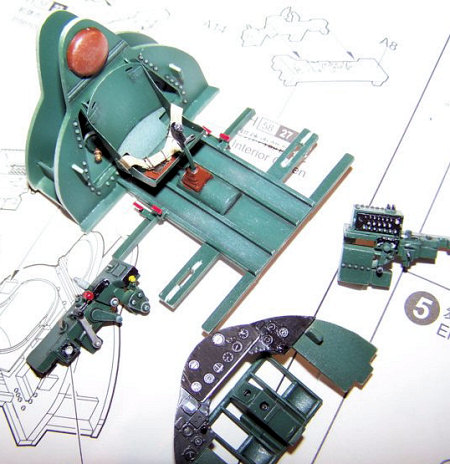 Begins in the cockpit. Eduard's photo etch seat was used, as well
as their instrument panel. The kit part is too plain. I like to back up my
I.P.'s with white styrene, which shows up the gauge detail when glued together.
The increased thickness of the "sandwich" I.P. requires slight trimming of the
cockpit side panels. When assembling the interior parts, dry fitting is
essential, as some trimming of the bulkheads is necessary to get the fuselage
halves to meet properly. Also, the cockpit side panels require some cutting down
to fit in without slanting. Trumpeter has provided a proper "floor" for the F4F,
this being two troughs for the pilot's feet and not a floor at all. I made up
the gun charging handles along the troughs, and added a few knobs and
handles.The etched seat belts were put in, lap belts only as the early Cats had
only these. My Wildcat-intensive buddy told me Model Master "Euro Green" was a
good Grumman cockpit color, so it was duly sprayed, and details painted
according to the few interior shots I had. I mixed some with a little white, and
resprayed the center ares for contrast, followed by light drybrushing with light
gray.
Begins in the cockpit. Eduard's photo etch seat was used, as well
as their instrument panel. The kit part is too plain. I like to back up my
I.P.'s with white styrene, which shows up the gauge detail when glued together.
The increased thickness of the "sandwich" I.P. requires slight trimming of the
cockpit side panels. When assembling the interior parts, dry fitting is
essential, as some trimming of the bulkheads is necessary to get the fuselage
halves to meet properly. Also, the cockpit side panels require some cutting down
to fit in without slanting. Trumpeter has provided a proper "floor" for the F4F,
this being two troughs for the pilot's feet and not a floor at all. I made up
the gun charging handles along the troughs, and added a few knobs and
handles.The etched seat belts were put in, lap belts only as the early Cats had
only these. My Wildcat-intensive buddy told me Model Master "Euro Green" was a
good Grumman cockpit color, so it was duly sprayed, and details painted
according to the few interior shots I had. I mixed some with a little white, and
resprayed the center ares for contrast, followed by light drybrushing with light
gray.
Due to my chosen assembly sequence, it was time to work on the
wings/gun bay. I closed up the right side, but the left ammo box was installed
per instructions. The barrels they give you for the F4F-3 guns were skinny
lookin', so I stole the barrels off the F4F-4 guns that were still in the kit.
These would be installed later sfter painting. The -4 etched set has gunbay
sides that I modified to work in my bay, and I added some piping and stretched
sprue cocking cables.Dzus fastener holes were drilled along the cover sides as
per references, and this area was sprayed with my own "green chromate" mix of
yellow chromate and black, guns black with aluminum
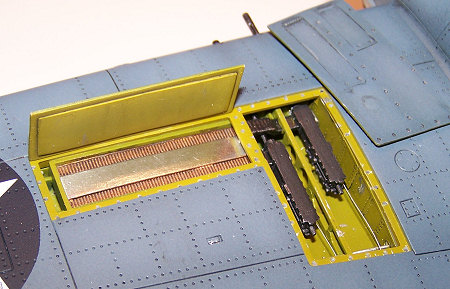 drybrushing, and brass ammo-nition.
Ailerons were deflected slightly (yes, purists, the control stick reflects
this),and the wing halves glued up.
drybrushing, and brass ammo-nition.
Ailerons were deflected slightly (yes, purists, the control stick reflects
this),and the wing halves glued up.
Before sticking the fuse. halves together I followed a hint from
Cleaver, and installed the wings to the halves. This allows gluing strongly
from the inside, without getting glue smears on the outside. The mid-wing
Grumman makes this happen. Now the new Trumpeter F4F-3 wings seem to be molded
too wide in chord and thickness for the raised bosses on the fuselage halves. I
tried to hide the thickness problem as best I could, as I didn't want to sand
off all the rivet detail. Sanding the chord down to match the boss fore and aft
camouflaged this fairly well. At this point the landing gear bulkhead has to be
painted, this being light grey. The landing gear chains that were molded in
lacked detail, so I added some with exacto blade and scriber, and painted them
gunmetal. After countless dry fits and trims, the fuse. halves can be joined. I
now use Tamiya Ultra thin cement. This stuff really is nice to use, it travels
the tiniest seams beautifully. Careful glueing leaves easy seam fixing and panel
line repair.
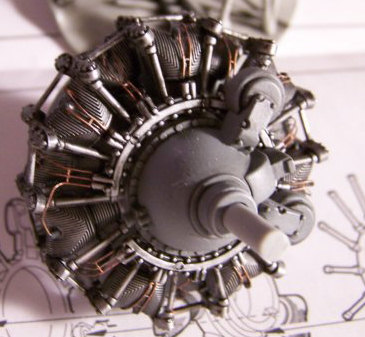 Another part new to the F4F-3 is the intercooler, parts G2 and G3. When
installed according to the plans, the engine bearers in step 6 slant up at a
strange angle, but this is necessary to fit into the center of the intercooler
parts and to line up the landing gear struts right. Again, test fit EVERYTHING
multiple times to see how it all goes together. At times this kit seemed more
like some limited run models I've built. Finally it was time to start masking,
the gear bays stuffed with tissue and cockpit taped off. The cowling, previously
sprayed inside with Chromate, stayed put by itself on the fuselage and was
painted with the rest.
Another part new to the F4F-3 is the intercooler, parts G2 and G3. When
installed according to the plans, the engine bearers in step 6 slant up at a
strange angle, but this is necessary to fit into the center of the intercooler
parts and to line up the landing gear struts right. Again, test fit EVERYTHING
multiple times to see how it all goes together. At times this kit seemed more
like some limited run models I've built. Finally it was time to start masking,
the gear bays stuffed with tissue and cockpit taped off. The cowling, previously
sprayed inside with Chromate, stayed put by itself on the fuselage and was
painted with the rest.
| COLORS & MARKINGS |
After waiting three weeks for some non-arctic temperatures in the New
York area to paint in (I paint outside), I finally got a 30 degree afternoon.
Colors selected were Model master 2038 Light grey unders, and 1720 Intermediate
Blue uppers. The intermediate blue may not be exact, but it looked like the
right early war color when I was done with all my shading and mixing. Now,
looking at the often seen photo of Wake Wildcat 211-F-11, lying in the Wake
boneyard, one sees the distinctive way the bottom grey goes up and around the
cowl. This was probably the easy way to mask off the engine area when the blue
uppers were sprayed on. I sprayed the bottom grey first, then using the pic for
reference, carefully freehanded the uppers with my new Paasche fine tip. I'mma
tella you, it took a while for my fingers to thaw out from this paint session.
Ah. the pain we suffer for our art! OK, that's enuff self- pity.
On to the good part. I mixed a small
amount of white with the blue in a very thin mix, and highlighted inside the
panels, and 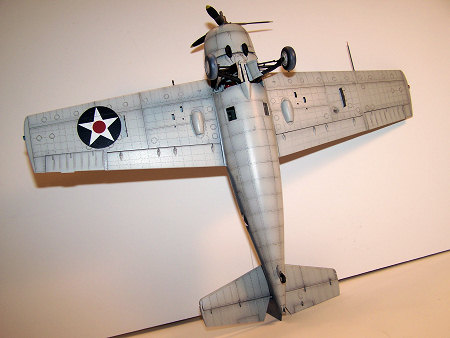 even between some of the rivetted areas, skipping some of them for a
varying look. Also, the fabric control surfaces were given this treatment. Next
a darkened blue mix was used over the panel lines, and a thin black mix on the
panel lines on the bottom. It looked a bit garish at this point, but I find if I
don't overdo it in the beginning, the gloss and flat overcoats later will end up
knocking things back where they don't show up enough for me. After allowing a
day for everything to settle down, I lucked onto another sprayable afternoon and
layed on the Testor's Metallizer sealer I use for glosscoating. Upon this coat
drying, I could begin putting on my lucked- onto decals.
even between some of the rivetted areas, skipping some of them for a
varying look. Also, the fabric control surfaces were given this treatment. Next
a darkened blue mix was used over the panel lines, and a thin black mix on the
panel lines on the bottom. It looked a bit garish at this point, but I find if I
don't overdo it in the beginning, the gloss and flat overcoats later will end up
knocking things back where they don't show up enough for me. After allowing a
day for everything to settle down, I lucked onto another sprayable afternoon and
layed on the Testor's Metallizer sealer I use for glosscoating. Upon this coat
drying, I could begin putting on my lucked- onto decals.
During one of my multiple visits (some say haunting) of my local hobby shop, I was delighted to find two new Yellow-Wings decal sets.These were # 32-012 Pre WW2 national insignia, a sheet with various size stars, and the corker, #32-004, for early Wildcats. This sheet had a Bunch of 1/2 inch size numbers which looked very close to what I needed to make dear old last survivor Wildcat no. 8, including lots of 2's, 1's, and F's. Bingo! Get out the scissors. Looking at 211-F-11, It seems the "2" is a different style than the one on the sheet, but can be modified by appropriate cutting and pasting. The best sized stars were picked and applied, then the 3 piece Twos were carefully put on all at the same time. The quality of the Yellow Wings decals sure helped here, as they were very easy to work with and responded well to Solvaset decal solution. After this, all the rest were easy, and the end result pleased me.
Next, it's time to start putting on my water- based black wash on all the panel lines and rivets, on a 1/32nd Trumpeter kit this is no mean task. Careful removal of the wash on the ailerons and elevator raised detail really shades the fabric surfaces well.
| FINAL CONSTRUCTION |
Let's put the Cat on it's feet. Upper landing gear struts are light
grey, the rest of the lower parts are black on most Wildcats. The lower gear
covers from the photo set atre far superior to the kit parts. These were bent
and installed, light grey outside, black inside. Now the kit gives you rubber
wheels with deep diamond tread-WRONG. All pictures I saw were smooth tread.
After finding  no resin smooth wheels available, I filled in the tread on the
rubber tires with CA glue, and sanded them smooth. Then the wheels/tires were
assembled, and I cast new ones using the Alumilite RTV and resin. The tail wheel
in the kit seems about the right size to represent the pneumatic land-based tire
Wake Wildcat's had. Several types of propeller paint jobs can be seen in photos,
but a blurry picture taken by the Japanese occupiers of a Wildcat in a shelter
barely shows the prop with aluminum hub and cuffs, black blades with yellow
tips. The etched sheet has bomb racks, these being an important feature of
VMF211's planes, and put in the place under the wings the best I could figure
was the correct spot.
no resin smooth wheels available, I filled in the tread on the
rubber tires with CA glue, and sanded them smooth. Then the wheels/tires were
assembled, and I cast new ones using the Alumilite RTV and resin. The tail wheel
in the kit seems about the right size to represent the pneumatic land-based tire
Wake Wildcat's had. Several types of propeller paint jobs can be seen in photos,
but a blurry picture taken by the Japanese occupiers of a Wildcat in a shelter
barely shows the prop with aluminum hub and cuffs, black blades with yellow
tips. The etched sheet has bomb racks, these being an important feature of
VMF211's planes, and put in the place under the wings the best I could figure
was the correct spot.
The canopy parts looked nice and clear, and I masked and sprayed the frames to match the rest of the paint job. The windcreen fit perfectly, then---Here we go again. Another kit where the Gott-Dam sliding part won't fit over the fuselage spine. What is with these manufacturers? After my last experience messing up a canopy trying to get it to fit, this one stays closed. It's clear enough where you can see SOME of my interior work.GGGGRRRRR. Landing lights next, painted with Tamiya clear red and green. If you haven't tied the Tamiya clear paints yet, give 'em a shot. They look like lights when done. The machine gun barrels were drilled next, and installed in their staggered arrangement. Now armed and dangerous, antennas and pitot tube finished her off.
| CONCLUSIONS |
Well I think we have a pretty good representation of what no.211-F- 8
looked like on the eve of war. It is a model I've wanted to build for a long
time. This really is the first properly kitted F4F-3 in any scale, and
Trumpeter has done a good job of backdating their F4F-4 to do it. Not the
easiest 1/32nd kit you'll ever build, due to the cockpit and interior fit
problems, but far from the worst. Ah recommends it to modelers of some
experience. If anyone tries the large Trumpeter VF-6 decals, please let me know
how they worked for you. That color scheme is a neat, colorful one.
April 2007
| REFERENCES |
Wake Island Pilot John F. Kinney with James McAffrey Memories
of War series Potomac Books, Inc. 2005
F4F Wildcat In Action Squadron Signal Publications Aircraft #
191 2004
Wake Island The Heroic Gallant Fight Duane Schultz 1978
http://www.ibiblio.org/hyperwar/USMC/USMC-C-Wake.htm Wake Island battle
website
Bill Koppos
Copyright ModelingMadness.com. All rights reserved. No
reproduction in part or in whole without express permission. If you would like your product reviewed fairly and fairly quickly, please
contact the editor or see other details in the
Note to
Contributors. Back to the Review
Index Page 2015